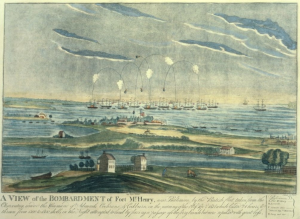We’ll hear “The Star-Spangled Banner” played a number of times over the next few days, and no doubt, we’ll think of fireworks when we hear “the rockets’ red glare/the bombs bursting in air.”
But, as we explain in the July/August issue of American Spirit, which Hammock publishes with the Daughters of the American Revolution , the rockets that Francis Scott Key immortalized weren’t playthings. They were a British system of military rocketry that largely failed to carry out its mission against Fort McHenry, the fort that defended Baltimore Harbor during the War of 1812.
, the rockets that Francis Scott Key immortalized weren’t playthings. They were a British system of military rocketry that largely failed to carry out its mission against Fort McHenry, the fort that defended Baltimore Harbor during the War of 1812.
Designed by the English inventor Sir William Congreve and modeled on rockets used against the British in India by Indian troops, the rockets that flew over Fort McHenry weighed about 32 pounds and had two major deficiencies—they were unreliable, inaccurate and also tended to explode prematurely.
The rockets fired on September 13, 1814, were launched from the British ship Erebus, and ultimately did little physical damage, though the screaming, wildly gyrating rockets terrified American defenders.
Congreve’s rockets consisted of an iron tube packed with propellant and a conical warhead, with three interchangeable payloads including incendiary devices, explosives and case shot—anti-personnel devices that exploded and sprayed iron balls in a lethal cloud. They ranged in size from 3 to about 32 pounds, and could be fired from ships as well as by troops on the ground.
 The 32-pound rockets were about 42 inches long and 4 inches in diameter, and had a 15-foot-long stabilizing rod. These rockets had a range of about 3,000 yards, farther than most artillery of the day, if they flew straight.
The 32-pound rockets were about 42 inches long and 4 inches in diameter, and had a 15-foot-long stabilizing rod. These rockets had a range of about 3,000 yards, farther than most artillery of the day, if they flew straight.
Erebus fired mostly incendiaries at Fort McHenry, and failed to do much damage. The British used rocketry against U.S. troops at the Battle of Bladensburg, and the exotic, erratic weapons sowed terror and panic among the Americans.
The rockets were more directly effective against Washington, D.C., where incendiary warheads set the city afire. The British used rockets during the Napoleonic Wars, including incendiaries that burned Copenhagen, Denmark, then a French ally. Their inaccuracy limited their effectiveness except as a largely psychological weapon.
Rockets gradually were phased out of regular military use until they were reintroduced in World War II.

